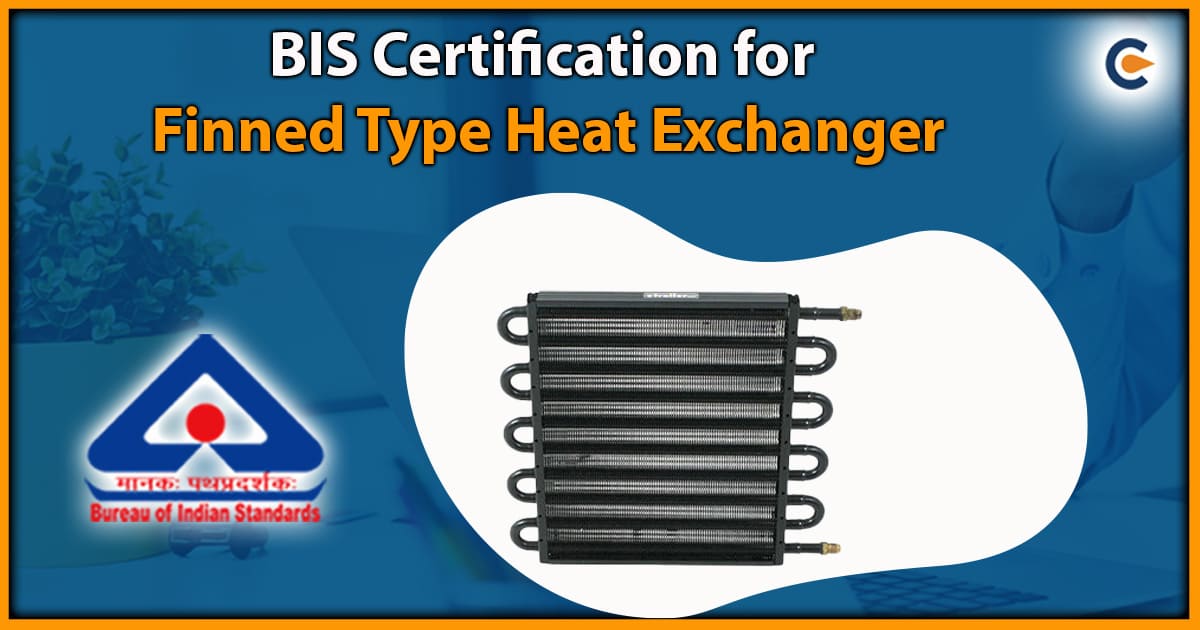A finned type heat exchanger is a device designed to facilitate the transfer of heat between two fluids or substances. It is composed of a series of tubes or channels with fins attached to them. The primary function of these fins is to amplify the surface area available for heat transfer, resulting in more efficient exchange of heat between the fluids. In this blog, we will explore how to apply for BIS Certification for Finned Type Heat Exchanger in detail.
An Outlook on the IS 11329:2018, an Indian Standard for finned type heat exchanger
The IS 11329:2018 standard encompasses the finned type heat exchanger for room air conditioners. It outlines the general requirements and testing procedures for the manufacturing of various sizes and types of air conditioners.
This standard specifically addresses the design, construction, inspection, and testing aspects of finned type heat exchangers used in room air conditioners for both heating and cooling applications.
Classification by Construction Method
Heat exchangers are categorized as per to their construction method as follows:
Fin pack with collar & tube type, & Micro channel tube having continuous fin type.
For each classification of heat exchangers, it is paramount to conduct comprehensive vetting that encompasses the entire range of varieties within that classification.
The tubes utilized in these heat exchangers must be constructed from either copper or aluminium and must meet the specified standards outlined in IS 11329:2018. Specifically, the aluminium tube material should comply with IS 737, while the copper tube material should conform to IS 10773.
Furthermore, the fins employed in the heat exchangers must be made of aluminium and should adhere to the relevant standards. The visible surfaces of the fins must be clean and devoid of porosity, inclusions, puncture points, scratches, scrapes, and any other imperfections that may compromise their performance.
To prevent the entry of dust or liquid into the tubes, the heat exchanger’s inlet and outlet tube ends must be sealed using rubber grommets or plugs. This sealing mechanism ensures the integrity and efficiency of the heat exchange process.
Tests to qualify for BIS Certification for Finned Type Heat Exchanger
The following test must be performed by manufacturer to qualify for BIS Certification for Finned Type Heat Exchanger:
- Corrosion Resistance test
- Burst test
- Fatigue strength test
- Construction test
- Leak test
- Internal Contamination
Underlining the marking and labelling norms for finned type heat exchanger
Every finned type heat exchanger intended for room air conditioners must be marked with the specific information outlined in the standard. Additionally, the Standard Mark (ISI Mark) can be affixed to each finned type heat exchanger designed for room air conditioners.
In compliance with the requirements specified in this standard, the product has the potential to receive certification under the provisions of the Bureau of Indian Standards Act, 2016, along with the associated Rules and Regulations. Consequently, the product(s) can be marked with the Standard Mark (ISI Mark).
To utilize the Standard Mark (ISI Mark), the manufacturer must obtain a BIS license from the Bureau of Indian Standards[1]. The granting of this license is contingent upon a successful evaluation of the manufacturing infrastructure, quality control measures, testing capabilities, and production processes implemented by the manufacturer.
Documents required for BIS Certification for Finned Type Heat Exchanger
The necessary paperwork for BIS certification of a finned type heat exchanger typically includes:
1. Application Form: A fully completed form provided by the BIS, containing details such as the applicant’s name, address, product information, and desired certification.
2. Test Reports: Reports from BIS-recognized laboratories, demonstrating the product’s compliance with the relevant Indian Standard.
3. Technical Documents: Specifications, drawings, or any other pertinent technical papers pertaining to the finned type heat exchanger.
4. Quality Control Manual: A documented manual outlining the manufacturer’s quality control procedures and processes to ensure consistent product quality.
5. Manufacturing Unit Details: Information regarding the manufacturing unit, including infrastructure, facilities, and quality control measures.
6. Trademark Registration: If the product bears a trademark, a copy of the registration certificate may be required.
7. Registration Fee: The prescribed fee for the BIS certification process, which varies based on the product category and certification scheme.
What is the process of BIS Certification for Finned Type Heat Exchanger?
Securing BIS (Bureau of Indian Standards) certification for a finned type heat exchanger involves the following steps:
1. Determine the Applicable Indian Standard
Identify the relevant Indian Standard that applies to the finned type heat exchanger.
2. Prepare the Required Documentation
Gather all the necessary paperwork, including the completed application form, test reports from BIS-recognized laboratories, technical documents, quality control manual, manufacturing unit details, trademark registration (if applicable), and the prescribed registration fee.
3. Submit the Application
Ensure the application form is accurately filled out and submit it along with the supporting documents to the BIS office or through their online portal.
4. Evaluation Process
The BIS will evaluate your application, carefully review the submitted documentation, and conduct an assessment of your manufacturing unit’s infrastructure, facilities, quality control measures, and production processes.
5. Testing and Inspection
The BIS may conduct tests and inspections on the finned type heat exchanger to verify its compliance with the applicable Indian Standard.
6. Certification Grant:
If your finned type heat exchanger meets all the requirements and successfully passes the evaluation process, the BIS will grant you the certification. You will then be issued the relevant certificate and permitted to display the Standard Mark (ISI Mark), if applicable.
To maintain the validity of your BIS certification, make sure to renew it within the specified timeframe. Stay updated with any changes or revisions to the Indian Standard and ensure ongoing compliance by adhering to quality control measures.
Conclusion
It is highly recommended to refer to the BIS guidelines, seek guidance from BIS officials, or consult with experts in the field to ensure a smooth and successful BIS certification process for your finned type heat exchanger.
Read our Article:How To Get BIS Certification For Hard Drawn Steel Wire?













